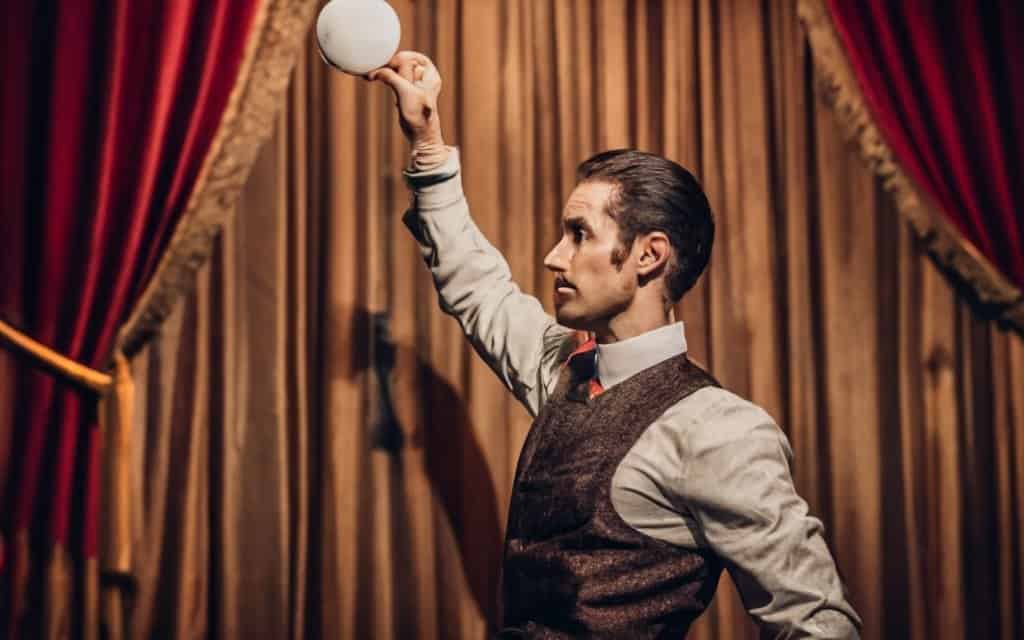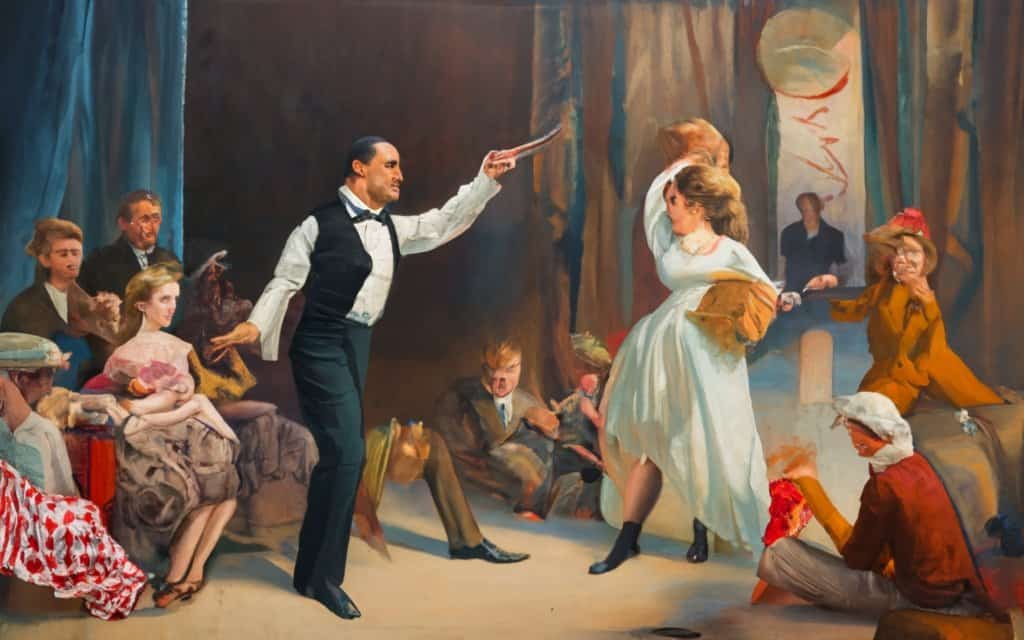 The Art of Stage Magic Tricks
The Art of Stage Magic Tricks
The craft of stage magic tricks has been mesmerizing audiences for centuries, taking them on a journey of wonder and disbelief. From the earliest performances in ancient civilizations to the grand spectacles of today, stage magic continues to evolve, captivating audiences with its ability to make the impossible seem possible.
The History of Magic on Stage
The history of magic on stage is as intriguing as the illusions themselves. The art of magic is believed to have originated in ancient Egypt, where priests used tricks to convince others of their divine powers. However, magic as a form of entertainment really began to flourish during the 18th and 19th centuries, with magicians like Jean Eugène Robert-Houdin and Harry Houdini becoming household names. These pioneers elevated the art form, introducing grand illusions and escape acts that would define the golden era of magic.
In the 20th century, stage magic experienced a renaissance, with magicians like David Copperfield and Penn & Teller bringing new life to the art form. Their innovative illusions and engaging performances helped to make magic relevant and exciting for modern audiences.
Understanding the Different Types of Magic Tricks
There are several types of magic tricks commonly used in stage performances. These include close-up magic, card tricks, coin tricks, mentalism, and grand illusions.
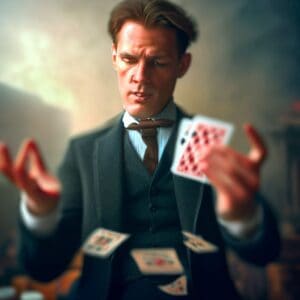
- Close-up magic involves performing magic tricks in close proximity to the audience, often using everyday objects. These tricks require a high level of skill and dexterity and can create a sense of intimacy and immediacy.
- Card tricks are a staple of many magic shows. They involve manipulating a deck of cards to perform various feats, such as predicting a selected card or making a card disappear and reappear in an unexpected place.
- Coin tricks involve sleight of hand techniques to create illusions with coins, such as making them disappear, change size, or multiply.
- Mentalism involves creating the illusion of mind reading or psychic abilities. This type of magic can be very powerful, as it appears to defy explanation.
- Grand illusions are large-scale tricks often involving props and assistants. These tricks can include making people or objects disappear, levitation, or escape acts.
These different types of magic can be combined to create a varied and exciting magic show. The choice of tricks will depend on the magician’s skills, the audience, and the setting. For more information on crafting a captivating magic show, check out our article on stagecraft for performing shows.
Remember, the key to a great magic show isn’t just the tricks themselves, but the way they’re performed. Presentation, timing, and audience interaction are all essential elements of a successful magic show. Visit our article on magic show performance tips for advice on how to enhance your stage presence and captivate your audience.
In the following sections, we’ll delve deeper into the specifics of stage magic tricks, offering insights into the intricacies of card tricks, coin tricks, mentalism, and grand illusions. Stay tuned to learn more about the art of magic and how you can master these tricks for your own performances.
Card Tricks
Card tricks are a staple in the world of stage magic tricks. They are a versatile and engaging way to entertain an audience. This section aims to provide an understanding of the basic principles that govern card tricks and highlight some popular ones used on stage.
Basic Principles of Card Tricks
Card tricks rely on a mixture of sleight of hand, misdirection, and the psychological manipulation of the audience. A successful card trick can create a sense of wonder and disbelief, leaving the audience amazed and questioning how the magician achieved the impossible.
The basic principles of card tricks often include forcing, where the magician influences the spectator’s choice of card, and control, where the magician manipulates the deck to know or change the position of a specific card. Another principle is the false shuffle, which gives the illusion of shuffling the deck while maintaining the order of the cards.
Mastering these principles requires practice and a strong understanding of the mechanics of card manipulation. While learning these skills, it’s important to remember that the presentation is just as important as the trick itself. For more on this, check out our article on stagecraft for performing shows.
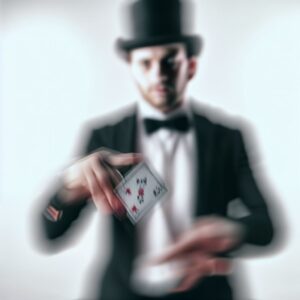
Popular Card Tricks Used on Stage
There are countless card tricks that have become popular on the stage. Some of the well-known ones are:
- The Ambitious Card: A card chosen by the spectator repeatedly rises to the top of the deck, no matter where it is placed.
- Card to Impossible Location: The spectator’s chosen card appears in an impossible location, such as a sealed envelope or the magician’s pocket.
- Prediction: The magician predicts the card that a spectator will choose before it is selected.
- Card Through Window: The spectator’s card is thrown at a window and appears to pass through the glass, sticking to the other side.
- Vanishing Deck: The entire deck of cards disappears from the magician’s hands, leaving only the spectator’s chosen card.
These tricks are just the tip of the iceberg when it comes to card magic. They can serve as an introduction to the vast world of card magic and provide a foundation for developing more complex routines. For more card tricks suitable for stage performances, check out our article on card tricks for magic shows.
Remember, the key to a successful card trick is not just the mechanics, but also the performance. The way you present the trick can make it more engaging and memorable, enhancing the magical experience for your audience. For more tips on improving your magic show performance, visit our guide on magic show performance tips.
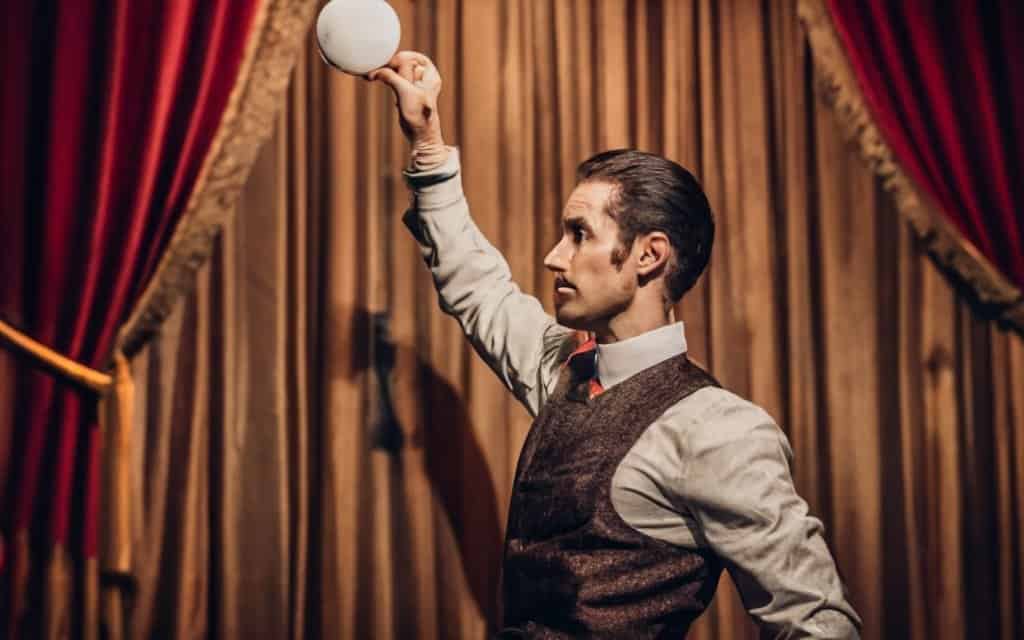 Coin Tricks
Coin Tricks
Coin tricks are an integral part of stage magic. They involve the manipulation of coins in such a way that they appear to perform actions that defy logic. This could be disappearing, reappearing, changing in size or color, and much more. Coin tricks are not only captivating but also provide an opportunity for audience interaction, making them a popular choice in many performances.
Understanding Coin Manipulation
Coin manipulation is the foundation of all coin tricks. It involves the skillful control of a coin or multiple coins using one’s fingers and hands. The effectiveness of a coin trick lies in the magician’s ability to control the coin seamlessly, creating an illusion of impossibility.
Understanding coin manipulation is critical to performing successful coin tricks on stage. It involves mastering techniques such as palming, where a coin is hidden in the palm of the hand, and sleight of hand, where swift, precise movements are used to create illusions. These techniques can take time and practice to perfect, but once mastered, they open up a world of possibilities for stage magic tricks.
For more information on mastering these techniques, check out our article on magic tricks for performing shows.
Common Coin Tricks in Magic Shows
There are several coin tricks that have become mainstays in stage magic due to their ability to captivate audiences. Here are a few common ones:
- The Disappearing Coin: This is perhaps the most iconic coin trick. The magician shows the audience a coin, places it in his hand, and then opens his hand to reveal that the coin has disappeared.
- Coin Transformation: In this trick, the magician shows the audience a coin and then changes it into a different coin, seemingly by magic.
- Coin Through Table: The magician places a coin on a table, covers it with a cloth, and then pushes the coin through the table, where it magically appears underneath.
- Multiplying Coins: The magician takes a single coin and magically turns it into multiple coins.
- Coin in Bottle: The magician takes a coin and a bottle with a neck smaller than the coin. He then magically makes the coin appear inside the bottle.
Remember, the key to successful coin tricks is not just the manipulation of the coins but also the engagement with the audience. Effective presentation and performance are just as important as the trick itself. For more tips on how to present your magic tricks effectively, check out our article on magic show performance tips.
By understanding and mastering coin manipulation, as well as the common coin tricks used in magic shows, magicians can create engaging and captivating performances that leave audiences in awe.
Mentalism
A key component of many successful magic shows, mentalism adds an element of mystery and intrigue that captivates audiences. A deeper understanding of mentalism can enhance the quality of any magic performance.
What is Mentalism?
Mentalism is a performing art in which practitioners, known as mentalists, use highly developed mental or intuitive abilities to demonstrate seemingly supernatural feats. These feats often involve telepathy, clairvoyance, divination, precognition, psychokinesis, mediumship, mind control, memory feats, and rapid mathematics.
In essence, mentalism is a performance art that involves manipulating the perception of others to create the illusion of extraordinary control over mind-related phenomena. It’s often used in combination with other stage magic tricks to create a well-rounded and intriguing magic show.
Incorporating Mentalism in Stage Magic
Incorporating mentalism into a magic show provides a unique twist that can leave audiences astounded. Mentalists, through their performances, create an environment where the impossible seems possible, and the line between reality and illusion is blurred.
In a magic show, mentalism can be used in a number of ways. A mentalist might appear to predict the future, read minds, or exhibit psychic phenomena. The key to a successful mentalism act is subtlety. The mentalist must be able to convince the audience that they are seeing genuine mental powers at work, rather than simple trickery.
The use of mentalism in a magic show can add depth to the performance and provide a refreshing contrast to more conventional magic tricks. It’s important to consider how mentalism can fit into the overall structure of the show and serve to enhance the other elements of the performance.
Performers interested in incorporating mentalism into their shows must be skilled in creating convincing illusions. This requires a thorough understanding of human psychology, the art of misdirection, and the principles of stagecraft. For more information on stagecraft and performance tips, check out our articles on stagecraft for performing shows and magic show performance tips.
Mentalism, when executed well, can be a powerful addition to any magic show. It provides a unique experience that leaves audiences questioning the line between reality and illusion, and craving more. For information on other magic tricks to incorporate into your shows, visit our article on magic tricks for performing shows.
Grand Illusions
When it comes to stage magic tricks, grand illusions are often the highlight of the show. These large-scale tricks captivate audiences with their complexity, spectacle, and the sense of wonder they inspire.
The Spectacle of Grand Illusions
Grand illusions are the epitome of stage magic, providing a visual spectacle that’s unmatched by other types of magic tricks. They usually involve large props, such as boxes, cages, or even cars, and often include the magician or their assistant as part of the trick.
The appeal of these illusions lies in their apparent impossibility. They might involve making a person disappear, sawing someone in half, or levitating an object or person. Despite the audience knowing it’s a trick, the illusion’s scale and the magician’s skill make the impossible seem real, if only for a few moments.
When executed well, grand illusions can create a powerful impact, leaving audiences in awe and enhancing the overall experience of the magic show. For more on enhancing your performance, check out our article on magic show performance tips.
Types of Grand Illusions in Stage Magic
Several types of grand illusions are popular in stage magic.
- Vanishing Acts: These tricks involve making something or someone disappear. The object of the trick may be a person, an animal, or a large object like a car or a cage of birds.
- Transformation Illusions: In these illusions, the magician changes something from one state to another. This could involve changing the color of a scarf, turning a staff into a snake, or transforming one object into another.
- Escapology: This type of illusion involves the magician freeing themselves from restraints, such as chains, handcuffs, or locked boxes.
- Levitation Illusions: These tricks involve the illusion of defying gravity. The magician may appear to float in the air, or they may make another person or object levitate.
| Type of Grand Illusion | Description |
|---|---|
| Vanishing Acts | Making something or someone disappear |
| Transformation Illusions | Changing something from one state to another |
| Escapology | Freeing themselves from restraints |
| Levitation Illusions | Creating the illusion of defying gravity |
The grand illusion a magician chooses to perform will depend on their skills, the available resources, and the audience they’re performing for. Regardless of the type, grand illusions hold a special place in the world of stage magic, offering a level of spectacle and excitement that’s hard to match. For more information on choosing the right tricks for your show, see our article on magic tricks for performing shows.
Building a Magic Show
Creating a captivating magic show involves more than just mastering individual tricks. It requires careful selection of stage magic tricks, thoughtful sequencing for maximum impact, and a well-practiced presentation and performance.
Choosing the Right Tricks

The first step in building a magic show is selecting the right tricks. The choice of tricks should align with the magician’s skill level, the audience’s preferences, and the overall theme of the show. For example, a show aimed at a family audience might include a mix of card tricks, coin tricks, and grand illusions, while a show for a more mature audience might lean more heavily on mentalism and sophisticated sleight of hand.
When selecting tricks, it’s also important to take into account the venue and the available stagecraft. Some tricks require specific staging or lighting conditions, while others can be performed in a variety of settings. Make sure to review our article on stagecraft for performing shows for more information.
Sequencing Tricks for Maximum Impact
Once the tricks have been selected, the next step is to sequence them for maximum impact. The sequence of tricks should build up to a grand finale, with each trick leading naturally into the next. A good rule of thumb is to start with simpler tricks to engage the audience, gradually introducing more complex and impressive tricks as the show progresses.
A well-planned sequence can also help to manage the pacing of the show, ensuring that there are no lulls in the action. For more tips on sequencing tricks, check out our article on magic show performance tips.
Mastering Presentation and Performance
The final key to a successful magic show is a well-mastered presentation and performance. This includes not only the execution of the tricks themselves, but also the magician’s stage presence, audience interaction, and storytelling abilities.
A polished performance can elevate even the simplest of tricks, while a poorly delivered trick can fall flat, no matter how complex or impressive it might be. Make sure to spend ample time rehearsing not only the tricks themselves, but also the delivery and timing of each trick.
Remember, a magic show is not just about the tricks – it’s about creating an unforgettable experience for the audience. For more advice on mastering presentation and performance, take a look at our article on magic tricks for performing shows.
By carefully selecting, sequencing, and mastering your stage magic tricks, you can create a magic show that will leave your audience in awe. Whether you’re a seasoned pro or a budding amateur, these three elements are key to a successful magic show. Happy conjuring!
